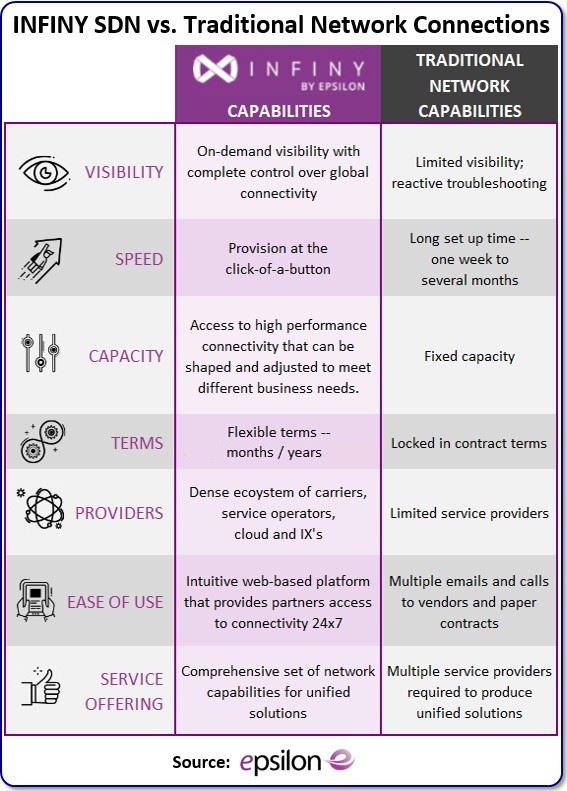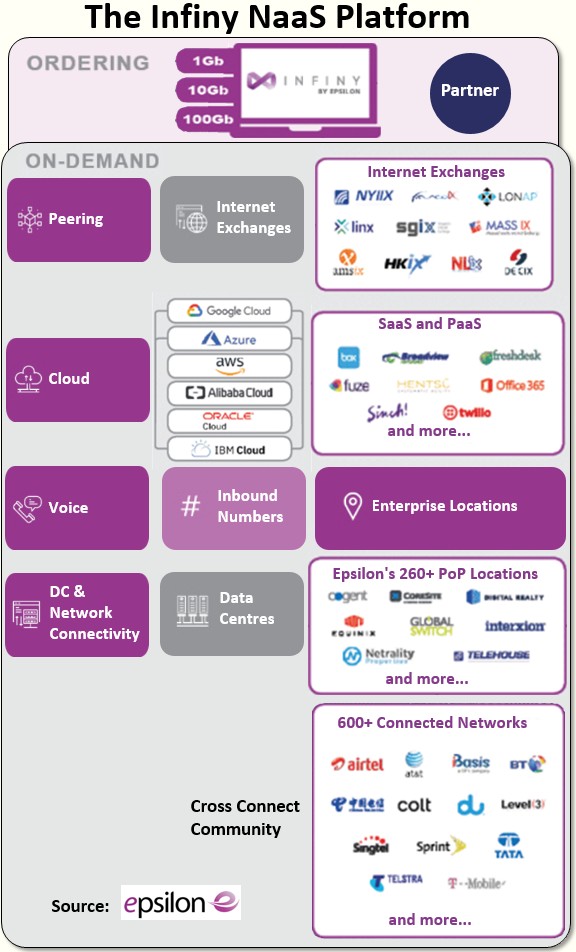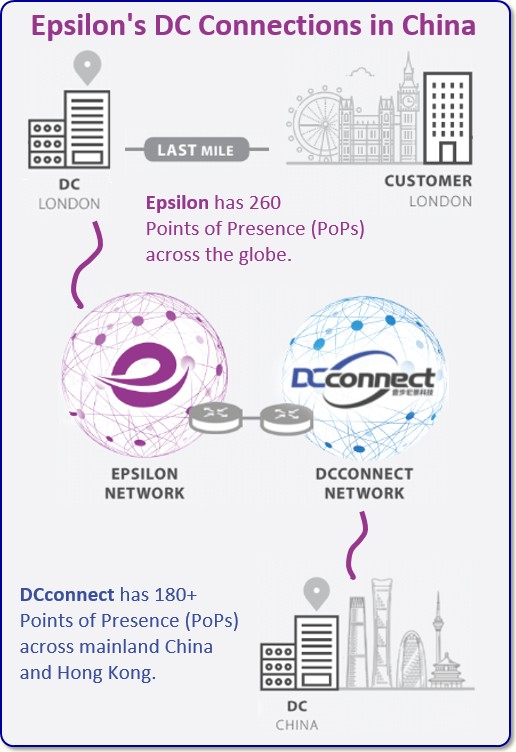| © 2022 Black Swan Telecom Journal | • | protecting and growing a robust communications business | • a service of | |
| Email a colleague |
April 2021
Epsilon’s Infiny NaaS Platform Brings Global Connection, Agility & Fast Provision for IoT, Clouds & Enterprises in Southeast Asia, China & Beyond

The goal of any brick and mortar business — large or small — is to achieve a kind of regional monopoly. Whether you own an upscale fashion boutique or a bargain pizza restaurant, your aim is the same: deliver the best value or experience for the target customers who live close enough to visit your shop.
For decades, telecom data centers lived by these same regional rules. Not long ago, I had the pleasure of touring 60 Hudson Street, the largest data center on Manhattan Island, New York City. Originally built in the 1930s by Western Union, it ran the largest telegraph business in the city. Young women were hired there to wear roller skates to deliver urgent (low latency) paper telegrams to messengers on the other side of the building.
Decades later, 60 Hudson Street became a telecom data center and remains today a premium DC, hosting the big name tech and cloud companies of the world.
Yet, thanks to tech innovation, 60 Hudson no longer holds a monopoly position in the New York metro. New submarine cables don’t land in Manhattan anymore: they connect first to DCs in New Jersey and Long Island. Even DCs in Montreal, Canada compete for New York biz because latency has improved and the abundance of hydroelectric dams and cold water in Quebec offer a cheaper and eco-friendly path to profit.
But the biggest disruptor to the data center business today is neither network hardware nor strategic location. It’s software in the network — SDNs — a faster, more agile, and more partner-friendly way of making global connections.
This is the area where Singapore-based Epsilon Telecommunications is innovating and directing its energy. Using its on-demand connectivity NaaS platform, Infiny, a developer in Jakarta can simply, quickly, and affordably test his cloud app with consumers in New York by connecting to 60 Hudson Street from the Infiny on-line portal.
Here to explain the power of Infiny and give insights on serving enterprises with cloud networking, and DC connectivity in Southeast Asia and China is Warren Aw, Managing Director of Epsilon’s APAC business.
| Dan Baker, Editor, Black Swan Telecom Journal: Warren, you recently joined Epsilon from another well-respected telecom, Colt Technology Services. Can you tell us about the opportunity you saw in coming to Epsilon? |
Warren Aw: Sure, Dan. I led the Singapore and Hong Kong team for Colt. And Colt is very well positioned in serving enterprises in Asia Pac, especially in the capital marketplace where they connect financial brokers and high-frequency traders.

But what attracted me to work here at Epsilon was their SDN or Network as a Service (NaaS) platform, Infiny. I see this as an exciting new way to deliver connectivity, offering superior network agility, provisioning speed, and partnership simplicity.
So, I saw how Infiny is opening up secure, global connections to an even broader set of customers beyond the finance industry. It’s a real catalyst to enable technology in the cloud, IoT, and 5G space for service providers and enterprises of all sizes in the region.
| What’s the main difference with provisioning a connection through Infiny? |
Well, the key difference with Infiny is an enterprise or app developer who wants to take its business global no longer needs to contract directly with a data center or multiple regional network operators in a specific geographical location. Epsilon has already built those required supplier frameworks, so an enterprise using Infiny can simply buy those connections on-demand from Epsilon — for as little as a month at a time.
Say a cloud application developer is connected to their core data center in Paris. Well, now they can quickly and flexibly push their services to an edge data center in another region. And to do that, they simply go to the Infiny portal to interconnect and scale up their bandwidth to the DC of their choice, testing their service after which they can scale it up or down depending on the commercial need.
So this is a highly scalable backbone Epsilon built. And the whole idea is to put control into the hands of the partner or customer.
| And we know that the traditional manner of connecting data centers is cumbersome. |
It’s a very slow process, Dan. Provisioning typically requires a few weeks’ notice: it could take 8 to 10 weeks to actually get the service.
Yet not many traditional carriers have moved to a platform model for fast provisioning. Remember, they have plenty of customers using legacy services — and naturally they want to protect that business.
So Infiny is really a leap forward. Not only are the connections provisioned on-demand, our contracts are flexible and they don’t require a long term commitment.
Frankly, our biggest challenge is spreading the word that there’s now a flexible way to deliver connectivity for enabling cloud applications. It also offers an agile networking approach which has many practical benefits in supporting service providers’ IoT and 5G solutions.

| How does your fast provisioning SDN work at the user case level? |
For example, an enterprise in Malaysia might say, “I want to increase the performance of my application hosted in Google’s cloud” to which we say, “Sure thing. We can enable a one-month service for you. We can quickly connect you to Google cloud for your Proof of Concept and we require no long term contract.”
So we provision the connection for them from the Malaysian Data Centre and the customer gets direct access to the Google’s cloud over our private network in Singapore, which in this case is where their cloud deployment is hosted. Now if the customer is pleased with the service, he can order 12 months of cloud connectivity — maybe at 100 Mbps for 12 months — or — if the business needs change in a couple of months and they want to scale up to 1 Gbps, they can do that too.
Geography is no longer a limitation. Infiny has a Point of Presence (PoP) in 260 data centers all over world. So if you’re in Europe, you can use our platform to reach the leading public cloud providers in Europe and also extend to other regions.
A variety of connections are available. It could be DC to DC (Data Centre Interconnect), DC to cloud (Cloud Connect), or DC to internet exchanges (Remote Peering). We also offer a service called Access which connects our customers to their last mile locations.
Internet peering is invaluable for ISPs. For example, if I set up an ISP today in Europe, then I need to connect to the major internet exchanges because that’s where everyone peers — in places like the London Internet Exchange (LINX), Amsterdam Internet Exchange (AMS-IX), and DE-CIX in Germany.
But you don’t have to build your own dedicated network backbone to connect to these Internet Exchanges. We are providing remote access to IXs from the world’s leading DCs so any customer who wants to connect to the IXs can do that to shorten their connectivity.
So Infiny becomes the primary customer engagement platform for interconnecting to DCs, clouds, and IXs globally.

| What markets are important to you in terms of raising adoption of the Infiny SDN? |
Well certainly we are very helpful to the cloud providers, especially as they port new customers.
I’ve been talking to cloud providers for 8 or 9 years and they face many regional challenges. Many of those challenges evolve out of the traditional way telecoms do business in APAC. For instance, service providers will say you need a minimum one-year service contract to get connectivity. That’s the norm, so it’s become a standard requirement.
But requiring one-year contracts defeats the value of cloud flexibility and agility. So, with Infiny, we are mirroring the agile commercial models of the clouds into the network underlay. We are also delivering the last-mile connectivity in places it has formerly been too hard or too expensive to get, providing a full end-to-end solution.
| I understand another fruitful path-to-market are independent “channel partners”. |
That’s right. You’ll recall it was the telecom channel partners who became an indirect selling channel for large providers. They mostly serve small-to-medium sized business (SMBs) who want to mix-and-match providers or get some telecom/IT integration help.
Channel partners started in voice and over time moved into selling broadband and mobile plans. But today, many of these channel partners are now cloud systems integrators. This is a very natural migration for them since their expertise is IT. So, for example, the channel partners who formerly sold Microsoft on-premises software and integration are now deploying Microsoft Azure workloads for their customers.
Now when these cloud service integrators or managed service providers talk to their customers, and the question is raised, “How can I guarantee the performance of my cloud-based applications?”, they can answer: “Well, we can offer an internet bypass solution through a provider like Epsilon.” So we’re bringing a key asset to these channel partners: we enable them to win more cloud business, and in many cases even monetise this value add.
Likewise, a customer might say, “All our IT services are on-premise now, but I want to migrate all that to the cloud.” And here, the integrator can say: “Sure, I can help you migrate to the cloud, but you may need a high-capacity connection for one month to transfer your loads of data into the cloud.”
Here again, Epsilon can get this set up with a simple contract.
| What cloud providers are serving your region? And what are the hot markets? |
Well in the Southeast Asia and Pacific region I’m serving, the cloud today is dominated by the major cloud players, such as Microsoft Azure, Google Cloud, AWS, IBM Cloud and Alibaba Cloud.
My personal view is we’ll start to see a lot of local cloud players emerge in the region, specialised by nature. And how will these startups survive? I think the secret is having a big domestic market as their base. For example, if you look at how AWS evolved, they initially focused on the U.S. market before they went international.
Same with Alibaba. They had a big national presence across China before they introduced their global cloud solution. So, we can eventually expect many cloud providers to rise in that huge market.
Another logical cloud seeding ground is Indonesia. Not only are there 275 million living there, the capital, Jakarta, has 30 million people spanning its metropolitan area.
Up until recently, Myanmar was also a lively market. A lot of expansion was happening there. Once the country is stable again, it will probably attract a lot of business. There are still big opportunities there. It’s just a matter of time.
Now Singapore is also an exciting place for business: the government is stable and the infrastructure is strong and efficient. Plus, many companies are coming into Singapore to setup a base for tapping into regional markets like Indonesia, Vietnam, and the Philippines.
| You mentioned China. And Singapore, of course, has strong cultural and business ties to China. Does your Infiny PoPs extend into China as well? |
Yes, we are there. And China is a special case and is absolutely a huge opportunity for business. Reaching big manufacturing and tech industry centers in China requires connections to scores of metropolitan areas. There are almost too many big cities to count! For instance, there are 113 cities with over a million people in China — and 11 of those cities have over 10 million people.
However, securing connectivity is hard because there are strictly enforced regulations on connectivity and traffic going in and out of China. Couple that with language barriers, public Internet blackouts, and trading regulations, and you realise that having a local partner is essential in China.
This is why Epsilon partners with DCConnect, a Chinese network operator who reaches all the key data centers across the country. So as a practical matter, when you use Epsilon’s Infiny platform, connecting to China is as easy, scalable, and flexible as connecting to any other DC in the world. DCConnect also uses an SDN orchestrator to reach 180+ Points of Presence (PoPs) across mainland China and Hong Kong.

| Warren, thanks for this briefing. A lot of good things are coming together in global connectivity in Asia Pac and it sounds like Infiny is the right product at the right time. |
Thanks, Dan. We certainly think so.
Epsilon was initially focused on carrier-to-carrier, but thanks to cloud adoption, direct-to-enterprise cloud adoption is where the demand is.
At the same time, channel partners and systems integrators are evolving to meet that need, so I think we have a big role to enable the move towards cloud, IoT, and 5G.
So we want to go after that business. Of course, we’ve already stepped into it.
We are hoping we are able to increase the adoption of Infiny because not many service providers have that platform vision.
As people use the platform and get educated to its benefit, ultimately that will attract more developers and more companies who deploy services with such quickness, contract flexibility, and one that easily adapts to their needs.
Copyright 2021 Black Swan Telecom Journal
Recent Stories
- Epsilon’s Infiny NaaS Platform Brings Global Connection, Agility & Fast Provision for IoT, Clouds & Enterprises in Southeast Asia, China & Beyond — interview with Warren Aw , Epsilon
- PCCW Global: On Leveraging Global IoT Connectivity to Create Mission Critical Use Cases for Enterprises — interview with Craig Price , PCCW Global
- Subex Explains its IoT Security Research Methods: From Malware & Coding Analysis to Distribution & Bad Actor Tracking — interview with Kiran Zachariah , Subex
- Mobile Security Leverage: MNOs to Tool up with Distributed Security Services for Globally-Connected, Mission Critical IoT — interview with Jimmy Jones , Positive Technologies
- TEOCO Brings Bottom Line Savings & Efficiency to Inter-Carrier Billing and Accounting with Machine Learning & Contract Scanning — interview with Jacob Howell , TEOCO
- PRISM Report on IPRN Trends 2020: An Analysis of the Destinations Fraudsters Use in IRSF & Wangiri Attacks — interview with Colin Yates , Yates Consulting
- Telecom Identity Fraud 2020: A 36-Expert Analyst Report on Subscription Fraud, Identity, KYC and Security — by Dan Baker , TRI
- Tackling Telecoms Subscription Fraud in a Digital World — interview with Mel Prescott & Andy Procter , FICO
- How an Energized Antifraud System with SLAs & Revenue Share is Powering Business Growth at Wholesaler iBASIS — interview with Malick Aissi , iBASIS
- Mobileum Tackles Subscription Fraud and ID Spoofing with Machine Learning that is Explainable — interview with Carlos Martins , Mobileum

